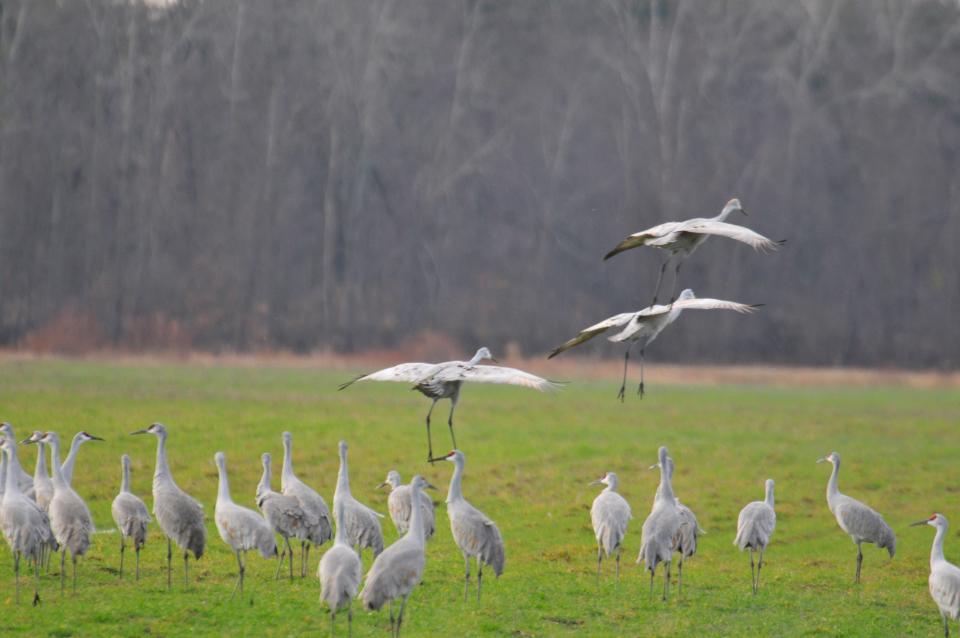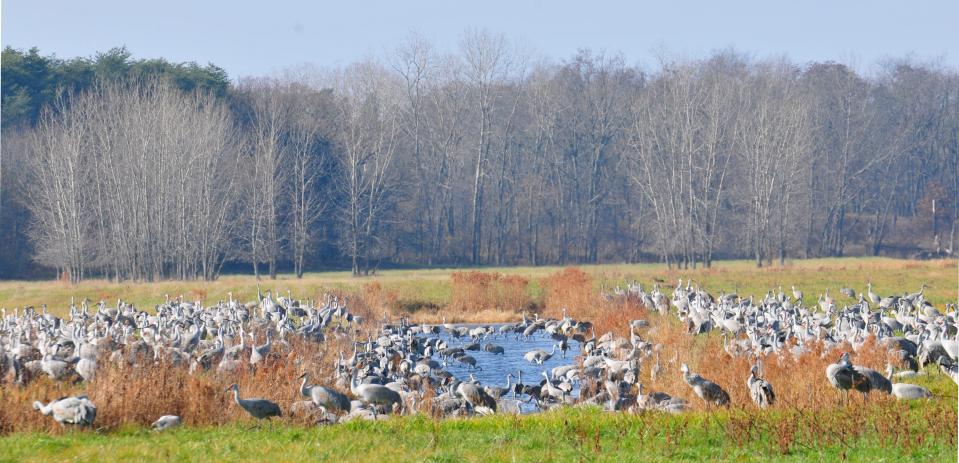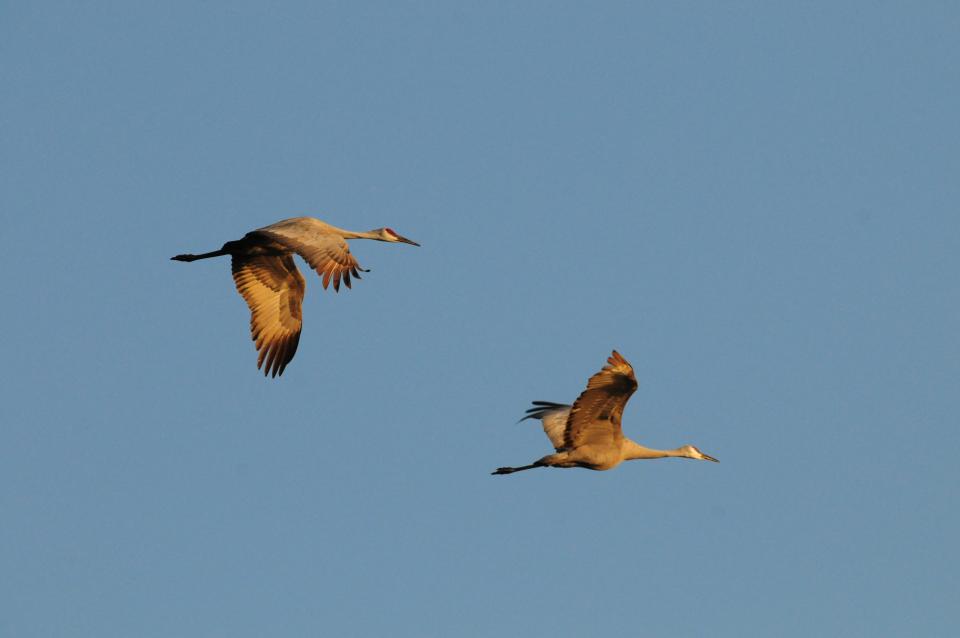Scrub Hub: What's that odd gobbling-like sound way up in the sky? Hint: It's not turkeys.
Have you heard a sort of odd gobbling — or, as ornithologist Allisyn-Marie Gillet describes it, the sounds of a novice trumpeter who “really needs quite a few lessons to improve” — in the sky?
Some of you may already know what's behind the noise, but for those who don't the answer is sandhill cranes. These majestic birds have been spotted (more likely heard first) flying over Indiana in recent weeks. And that won’t be stopping, at least not for a while.
Birdwatching: Have you spotted any of these birds yet? These are the 10 most common for March
So for this edition of the Scrub Hub, we’ll delve into the following questions: Why are there so many sandhill cranes on the move now? And where can I go to see them? To find the answers, we spoke with some bird experts.

Indiana a main stopover on the migratory path
Sandhill cranes are special for a few reasons, from their looks to their behaviors to their long history.
The noisey high-flyers are some of the largest birds in North America. With their long legs and neck, they stand nearly 4 feet tall and can sport a wingspan over 6 feet. Their bodies are mostly grey in color, but adults have a distinct red crown on their heads with pale white cheeks.
Scrub Hub: What is being done in Indiana to bring back American chestnut trees?
These cranes are among the oldest bird species still in the sky, according to Aidan Rominger, a naturalist at the Eagle Creek Ornithology Center. The oldest fossil records date back to 2.5 million years ago.
“This means that sandhill crane flocks were seen amongst mammoths, mastodons and other prehistoric mammals that inhabited Indiana,” Rominger said.
Gillet, an ornithologist with the Indiana Department of Natural Resources, loves the sandhills for some of their unique behaviors. They are a very social bird, she said, and often are seen together in large groups.

They also have over 20 different call types to communicate with each other, and even dance together by jumping up in the air and kicking out their feet, Gillet said. Another unique trait: While nesting the cranes will paint their feathers with the rusty, clay soil to better camouflage themselves and protect their young.
The reason Hoosiers are hearing and seeing so many Sandhill cranes now is because they are in the midst of spring migration. If you are thinking it seems a little early for that, you wouldn’t be wrong. In recent years, however, their migration patterns have been shifting in response to milder winters and larger temperature fluctuations in the fall and spring.
Invasive species: It's Invasive Species Awareness Week. Do you know what's lurking in your community or yard?
The eastern migratory population of sandhill cranes, believed to number around 110,000, largely summer in Michigan, Wisconsin and Canada.
During the fall, they fly south. Previously the cranes would travel as far south as the Gulf Coast, Gillet said. But more recently, few fly that far — and more are staying in Indiana due to the milder weather. In particular, they have been congregating at Jasper-Pulaski Fish and Wildlife Area in the state’s northwest corner and Goose Pond FWA in southern Indiana.
Gillet said sandhills seek two things when looking for somewhere to stay: Large areas of open water to be protected for roosting, and a source of food. The latter includes corn left behind in harvested fields and macroinvertebrates such as worms and crayfish.
“If they have those two things taken care of,” Gillet said, “that means they can stay there.”
But with the arrival of spring, or at least spring-like weather, the cranes head back north. That’s what’s happening now. The few warm days that popped up in February triggered many to start their return journey, and Indiana is directly in their flight path. Gillet said she wouldn’t be surprised if the entire 110,000-population of sandhills spends some time in Indiana throughout the year.
Gillet estimates the migration is near its midpoint, so Hoosiers can expect to see — or more likely hear — cranes for a few more weeks.

If you want to get a closer look, one of the the best places to see sandhill cranes now is the Jasper-Pulaski FWA, which can have thousands of cranes at any given time. The ideal times are around sunrise and sunset when they are coming in and out of the marshes.
Sandhills can fly for hundreds of miles in a single day, so it’s unlikely many will stop in more urbanized and developed areas such as Marion County on their journey north. A few may may pause at Eagle Creek Reservoir, but Rominger said most “Indianapolis residents should keep their eyes on the skies, and be listening for the sandhill cranes’ very distinctive trills.”
If you have any more questions about sandhill cranes or any other wildlife species, please ask us! You can submit a question to the Scrub Hub through the Google form below.
Call IndyStar reporter Sarah Bowman at 317-444-6129 or email at sarah.bowman@indystar.com. Follow her on Twitter and Facebook: @IndyStarSarah. Connect with IndyStar’s environmental reporters: Join The Scrub on Facebook.
IndyStar's environmental reporting project is made possible through the generous support of the nonprofit Nina Mason Pulliam Charitable Trust.
This article originally appeared on Indianapolis Star: Sandhill cranes soaring noisily over Indiana on their spring migration

